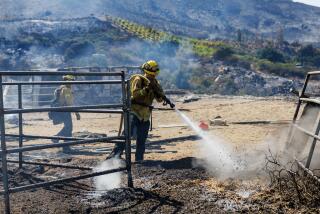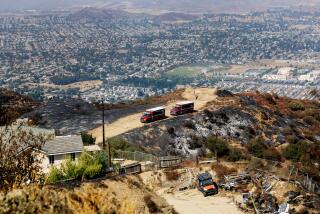Overwhelmed, Firefighters Can Only Hope to Save Lives
- Share via
A worst-case scenario of high temperatures, low humidity and Santa Ana winds sidelined efforts to contain wildfires raging across Southern California on Saturday, forcing fire crews to stand back and wait for the weather to turn.
And meteorologists predict more of the same today, if not a turn for the worse.
“Under these conditions, fires propagate very fast and you get situations where entire hillsides will burst into flame, so it’s very dangerous,” said Paul Zedler, a professor of environmental studies at the University of Wisconsin. “You can’t fault the firefighters for standing back and not trying to stop it.”
The best they can hope for is to save lives and whatever structures they can, Zedler and others said. “Anything else would be extremely dangerous,” he said.
Fire incident commanders trying to manage fires in San Bernardino, Los Angeles and Ventura counties are struggling for more resources: fire engines and personnel. As of Saturday morning, the state had deployed 48 strike teams, made up of five fire engines each, to Southern California from other parts of the state. During the day Saturday, 45 more teams were sent.
“We’ve really reached the limit in Southern California of additional resources we can call on,” said Eric Lamoureux, a spokesman for the Governor’s Office of Emergency Services. “We’re basically playing a big chess game across the state with fire resources -- identifying where our resources sit and how far we can draw them down.”
Lamoureux said authorities are fortunate because weather conditions have been agreeable in the Central Valley and the Sierra, allowing resources to be diverted away from there too.
Even with the infusion of extra crews, strategists managing the Old fire in Waterman Canyon were asking their counterparts from the Grand Prix fire for help. Both fires are in San Bernardino County.
“We said, ‘We’re already short over here,’ ” said Martin Esparza, a fire information officer for Angeles National Forest, which is contributing personnel. “If we had any crews available, we would have lent them.”
Added Mike Dietrich, incident commander of the Grand Prix fire and fire chief for San Bernardino National Forest, “All of our firefighting resources are stripped to the bare bones.”
In a sense, fires like these have their origin in the deserts of southern Nevada and Utah, where air heats up and then, under Santa Ana conditions, begins racing west toward the Pacific Ocean. When the winds reach Southern California, they pour across and through the mountains, corkscrewing through passes and sometimes building eddies.
All of this creates a nightmare for firefighters because the winds fan the flames. The fire spreads faster than they can contain it. At the same time, the winds render ineffective one of firefighters’ best tools -- aircraft -- not because they can’t fly, but because the retardant and water that they drop just blows sideways and misses its target.
“When conditions are extreme like this, there’s really very little they can do,” Zedler said. “You can’t keep up with it with the aerial bombers and the fire retardant. They just can’t keep enough planes in the air to stay in front of the fire in these conditions. It just exceeds the capacity to contain them.”
California is probably better prepared for fires than any other state, said William Teie, former deputy director for fire protection for the state Department of Forestry and Fire Protection. “It’s very unique in that it’s well-practiced in doing this,” he said. “It’s a blessing on one hand, but it’s a curse on the other.”
More to Read
Sign up for Essential California
The most important California stories and recommendations in your inbox every morning.
You may occasionally receive promotional content from the Los Angeles Times.













